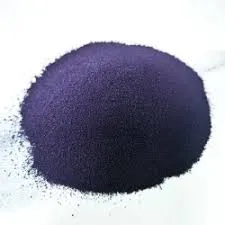Exploring the Artistry and Techniques of Indigo Dye Vat Production and Its Applications
The Art and Science of Indigo Dye Vat Products
Indigo dye has long captivated cultures worldwide, revered for its rich hues and deep historical roots. From ancient textiles to modern fashion, the journey of indigo dye involves a complex interplay of art, chemistry, and tradition. At the heart of this journey lies the indigo dye vat—a crucial component that transforms raw indigo into the vibrant blue we associate with high-quality textiles today.
The History of Indigo Dyeing
The use of indigo dye dates back thousands of years, with evidence of its application found in ancient Egyptian mummies and in the textiles of various indigenous cultures across Asia, Africa, and the Americas. This natural dye is derived from the leaves of the indigo plant, primarily Indigofera tinctoria. Historically, the process of extracting and preparing indigo for dyeing was labor-intensive, involving fermentation which allowed the indigo to be reduced into a soluble form called leucoindigo.
The indigo dye vat is essential for this process. Essentially, it is a large container filled with a mixture of water, fermented indigo, and alkaline substances, such as lye or wood ash. This vat creates an anaerobic environment, allowing the leucoindigo to dissolve. When fabric is dipped into the vat, it absorbs this solution and, upon exposure to air, oxidizes back to indigo, resulting in the striking blue color.
Creating the Indigo Dye Vat
Creating an indigo vat involves a delicate balance of ingredients and environmental factors. Artisans often rely on traditional recipes passed down through generations, adjusting elements based on local resources and climate. The types of indigo used, the method of fermentation, and the temperature can all influence the final hue and shade achieved.
indigo dye vat product

The fermentation process is one of the most crucial steps. It typically involves a mixture of water, indigo leaves, and additional organic materials such as sugar to create an environment conducive to the growth of specific bacteria. These bacteria break down the indigo, allowing it to enter a soluble state. Timing is essential in this step, as under-fermented vat results in weak coloration, while over-fermentation can lead to undesirable odors and complexity in the dyeing process.
Dyeing Techniques and Applications
Once the indigo vat is prepared, various dyeing techniques can be employed. The most traditional method is through immersion dyeing, where fabric is repeatedly dipped in the vat, layered to achieve darker shades. Another popular technique is tie-dyeing, where portions of the fabric are bound tightly to create intricate patterns. The resist dyeing method is also prevalent, where certain areas are protected from the dye using wax or stitches, resulting in stunning designs.
In contemporary contexts, indigo dye has seen a resurgence, particularly in the fashion industry where sustainability and authenticity have become major selling points. Brands are now exploring eco-friendly practices related to indigo production, including using organic cotton and natural fermentation processes that reduce environmental impact.
The Resilience of Indigo Culture
The culture surrounding indigo dyeing is rich and vibrant, embodying a sense of heritage and community. Contemporary artisans often merge traditional techniques with modern aesthetics, allowing for a renaissance of this ancient craft. Workshops and dyeing communities thrive globally, sharing knowledge, practices, and the unique stories that each piece of indigo-dyed fabric carries.
In conclusion, indigo dye vat products symbolize more than just color; they represent a profound connection to history, artistry, and sustainable practices. As consumers become increasingly aware of the stories behind textiles, the allure of indigo continues to grow. Whether adorning a garment or a piece of art, the deep hues of indigo will forever retain their enchanting charm, rooted deeply in the tapestry of human culture. As we embrace these traditions, celebrating both the science and artistry involved, indigo's legacy will undoubtedly flourish for generations to come.
-
The Timeless Art of Denim Indigo Dye
NewsJul.01,2025
-
The Rise of Sulfur Dyed Denim
NewsJul.01,2025
-
The Rich Revival of the Best Indigo Dye
NewsJul.01,2025
-
The Enduring Strength of Sulphur Black
NewsJul.01,2025
-
The Ancient Art of Chinese Indigo Dye
NewsJul.01,2025
-
Industry Power of Indigo
NewsJul.01,2025
-
Black Sulfur is Leading the Next Wave
NewsJul.01,2025

Sulphur Black
1.Name: sulphur black; Sulfur Black; Sulphur Black 1;
2.Structure formula:
3.Molecule formula: C6H4N2O5
4.CAS No.: 1326-82-5
5.HS code: 32041911
6.Product specification:Appearance:black phosphorus flakes; black liquid

Bromo Indigo; Vat Bromo-Indigo; C.I.Vat Blue 5
1.Name: Bromo indigo; Vat bromo-indigo; C.I.Vat blue 5;
2.Structure formula:
3.Molecule formula: C16H6Br4N2O2
4.CAS No.: 2475-31-2
5.HS code: 3204151000 6.Major usage and instruction: Be mainly used to dye cotton fabrics.

Indigo Blue Vat Blue
1.Name: indigo blue,vat blue 1,
2.Structure formula:
3.Molecule formula: C16H10N2O2
4.. CAS No.: 482-89-3
5.Molecule weight: 262.62
6.HS code: 3204151000
7.Major usage and instruction: Be mainly used to dye cotton fabrics.

